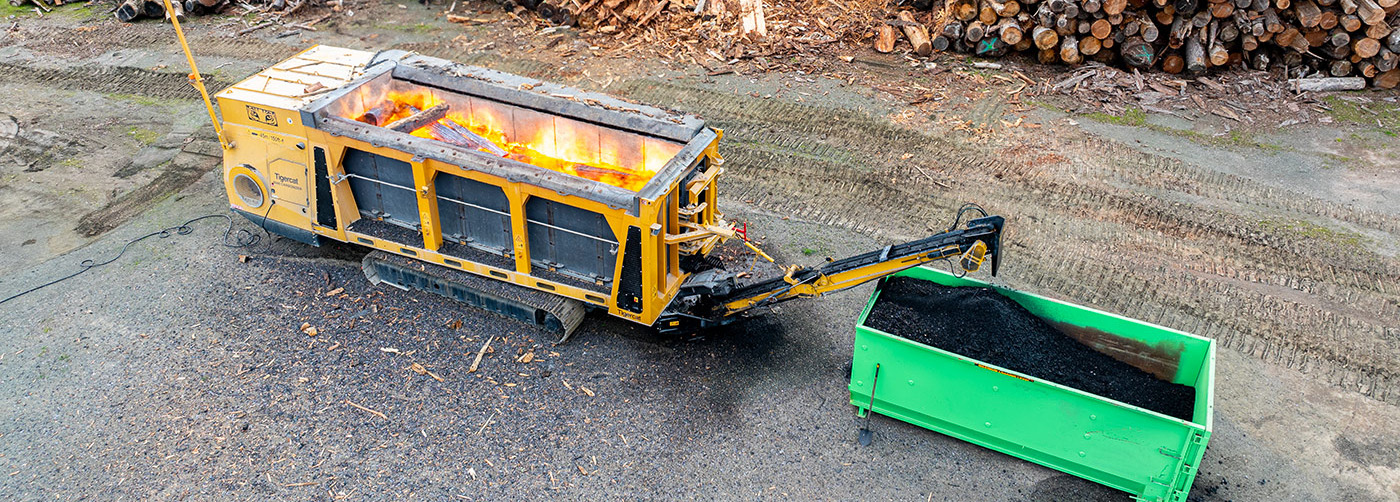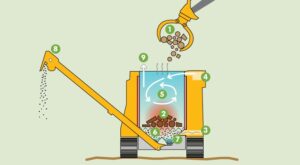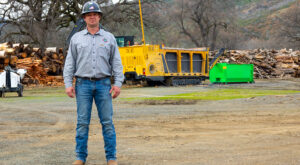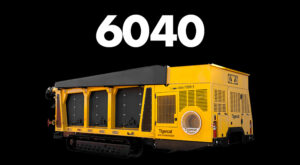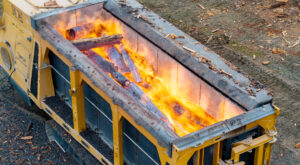Carbonizer FAQ
Frequently asked questions about the 6040 carbonizer, the carbonization process and the business model.
What is infeed rate? How much woody biomass can the 6040 process per hour?
The productivity of the 6040 is dependent on the type, size and moisture level of the infeed material as well as feeding practices and techniques. The average is 15-20 tons per hour. A continual feeding process with an approach of feeding smaller bites of material more frequently tends to produce the best results or highest pass-through yields.
Is there a requirement to preprocess the infeed material?
The ideal size of infeed material is 75-360 mm (3-14 in) diameter. The carbonizer will not process chipped or ground biomass. Large logs and stumps exceeding 360 mm (14 in) diameter will still be carbonized, but at a slower rate. Roughly breaking up large material increases surface area and promotes more efficient carbonizing.
Can green material be processed by the 6040?
For best production results, some drying time can be advantageous. Optimal moisture content is around 40%. There is a balance between the correct moisture content and not letting the material sit so long that is it begins to lose available carbon content. The infeed is reduced by about 90% and contains approximately 25-30+% of the available carbon. Old, dry material can affect the quality of the organic carbon output.
Is an external water supply required to operate the 6040 carbonizer?
A water supply of 450-680 L/hr (120-180 gph) is required to quench the organic carbon. An onboard pump and level control system keeps an ideal volume of water in the base auger trough where the organic carbon is quenched prior to being discharged. A secondary water supply for the intermittent sprinkler system requires 225 L/min (60 gpm). The water supply hook-up requires a 1½ in female camlock adapter at the customer’s end. An adequate supply hose of similar size from the water source is also required.
What is organic carbon used for?
Organic carbon, commonly known as biochar, has many uses. Used in soil remediation, biochar can absorb heavy metals and other soil contaminants. Because of its absorption properties, biochar can also be pre-charged with other organic materials before being tilled into the soil. The charged materials will slow release into the soil, enhancing the quality over time. Organic carbon can also be additive in the commercial production of compost, again, allowing for slow release of nutrients and improving water retention of the soil. Organic carbon retains moisture, lessening the negative impact of drought conditions.
Other industrial uses of organic carbon include air and water filtering application, remediation of water bodies and landfill leachate.
Will the 6040 process stumps?
Yes, but some pre-processing is required to remove the bulk of the soil and stones that come with the roots of the stump. Stones and soil are problematic because the material will tend to sit on top of the grates without deteriorating, steadily increasing in temperature and causing premature wear to the grates due to heat distortion. Also, the dirt and stone accumulation will block the under-air flow and disrupt the efficiency of the carbonization process. Soil that does fall through the grates will affect the quality of the organic carbon as it will be categorized as ash in standard lab analysis.
How does the permitting process work?
Permitting and approval processes are application and site specific. Tigercat may be able to assist with an evaluation of the operation and permit application assistance.
What is the benefit of using a carbonizer for material reduction over a chipper or grinder?
Chipping and grinding makes sense when the output is a marketable product. When there is no marketable product and the process is entirely for material reduction such as a post-storm clean-up, chipping or grinding material and transporting for disposal is very costly and fills regional landfills with organics. The emissions associated with decomposition of wood chips ground material is very large. There are costs and emissions related to the multi-step process: There is a cost to grind, as cost to load, a cost to haul and a cost to dispose.
Carbonizing on the other hand is a single step process, eliminating many of the costs and emissions associated with chipping or grinding for disposal. In fact, the carbonizer has a negative emissions profile. The carbonizer reduces volume, onsite by about 90% while manufacturing a near pure carbon. If the organic carbon is being transported offsite, the volume and associated hauling costs are much lower.

